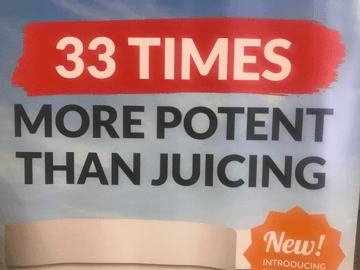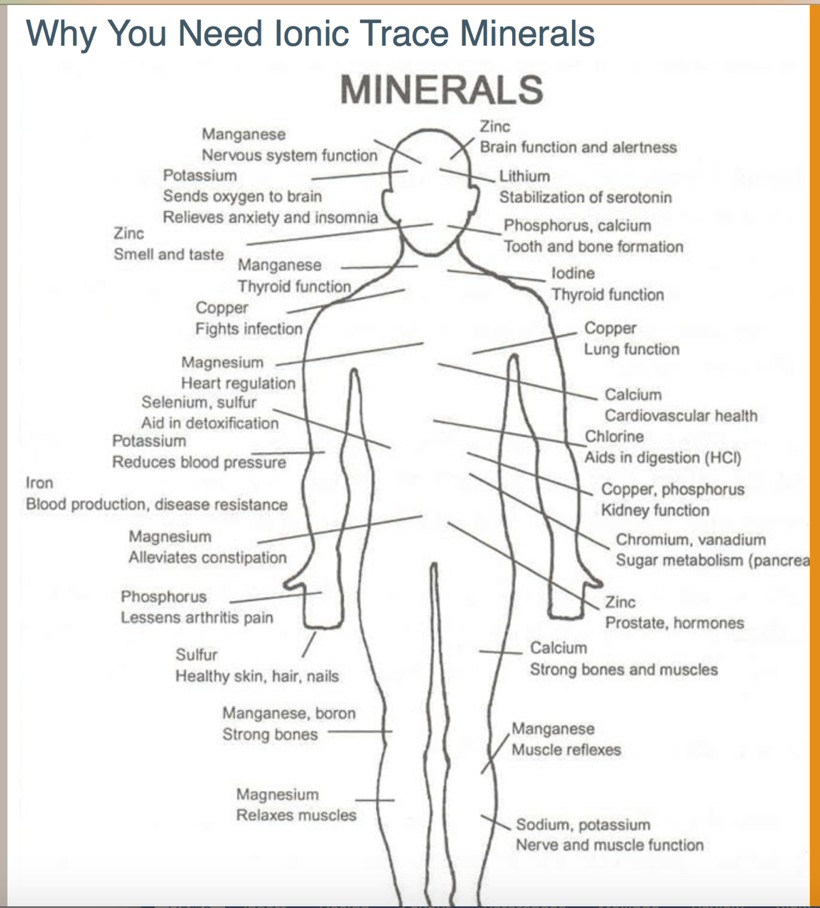Having just returned from Expo East, here are a few random thoughts on the state of the natural products industry—and a few of the trends and products I found particularly interesting.
On first impression, the state of the natural products industry is booming. That said, there’s a tremendous amount of “noise” enveloping any natural products show, and it often drowns out the “signal”. Just one example—CBD. As readers of this column know, I’m a big fan. There’s really something “there” there. It’s a serious supplement capable of doing serious things, and the emerging research on it is extremely promising. Yet to hear some vendors talk, you’d think it was a miracle drug that caused the lame to throw away their crutches and start dancing the macarena.
And it’s not just CBD. The marketing apparatus around natural products in general is out of control.Here’s an example. (I don’t mean to pick on the hapless manufacturer who posted this particular sign because there were dozens like it all over the trade show floor):
 OK folks, listen up. Any time you see a marketing claim like this, thefirstthing you should do is mentally roll your eyes. The next thing you should do is ask yourself a few pointed questions:
OK folks, listen up. Any time you see a marketing claim like this, thefirstthing you should do is mentally roll your eyes. The next thing you should do is ask yourself a few pointed questions:- 33% more potent than what?
- What exactly was it more effective at doing? (in this particular case, the manufacturer was advertising a detox product, so the question would be, what toxins specifically did it remove? In what amounts? And on what basis did you decide to measure those particular toxins rather than others?
- Was this a published study? Or something done “in house”?
In fairness, there’s so much noise and hype out there in the natural products marketplacethat manufacturers are almost forced to make bigger and bolder (and frankly, stupider) claims just to get any attention at all. But as a consumer, you’d be well advised to invest in some good earplugs.
That said, there are plenty of babies in the bathwater, so let’s not throw them out when we drain the proverbial tub. There were a lot of great products at the show this year, as well as some interesting trends. Starting with…
1. Hemp. Remember the classic scene in “The Graduate” when one of Benjamin’s parents’ friends took him aside to give him a “tip” on what to do after college? “Plastics, Benjamin,” the stuffy old executive says with a wink to a dazed Dustin Hoffman. “Plastics!” Well, if that movie were being made today, the old codger well might have said “Hemp!”
The day before Expo officially opened, there was a seminar on hemp, which I attended. You couldn’t help feeling like you were in on the beginnings of something really big. It felt like the early days of the internet when people were asking things like, “What’s this thing called aChat Room”? Hemp is about to go big-time—bigly.
With the anticipated passage of the Hemp Farming Act, hemp is coming out of the closet—where it’s been tainted by its much misunderstood relationship to marijuana—and stepping into the limelight as a major industrial plant and environmental hero. (Hemp draws toxins from the soil and carbon gases from the environment and is the ideal crop for healthy rotation and soil enrichment.) You can make all sorts of cool things out of it from paper to rope to oil. And it’s also—not incidentally—a major source of one of the most exciting compounds to be on display at Expo, CBD (cannabidiol), about which more in a moment.
Both marijuana and hemp are species of the same plant genus,Cannibas, but there are striking and important differences, one of which is that hemp has no THC, the active ingredient in marijuana that gets people stoned. More accurately, to be sold legally as hemp, a product can containno morethan .3% of THC. (Notthree percent, mind you, point 3 percent, which is 1/3 of 1 percent, a virtually meaningless amount of residue that wouldn’t get a gnat high.)
That’s one reason hemp oil is one of the big stories of this year’s expo.Theoretically, at least, a product made from hemp should avoid the legal quagmire aroundcannibas sativa (marijuana). As people begin to understand the endocannabinoid system and where cannabinoids come from and the difference between marijuana and hemp, look to see CBD products coming soon to a store near you.
What kind of a store is another matter. Big pharma is projected to spend about $342 million on hemp related products in 2020, projected to reach $625 million in 2022 (a projected growth very close to 100% in just two years). The drug companies will be involved, and will try to get as much as they can of this market under their control. Yet hemp oil will still (we hope) be able to be sold as a dietary supplement, with its naturally occurring CBD and other active ingredients like terpenes, fully intact.
Though many companies showed CBD products at the show—some of them very good-- my money is still on Barlean’s to break through the noise. Unlike many of the exhibitors at the show Barlean’s didn’t just spring up yesterday to jump into the hot CBD market—they’ve been doing high quality oil-extraction for 30 years and have an impeccable reputation for quality. And Barlean’s is the first nationally known company with major distribution and brand recognition to get into the CBD market. They introduced two new products at the show—an organic, 10mg per dose CBD oil and a extra-strength 25mg per dose version. Both got a tremendous amount of attention at the show, deservedly so in my opinion. (Full disclosure—I’ve been using the extra-strength version for my shoulder and it’s made a significant difference.)
2. Trace Minerals. Micronutrient deficiencies is a topic that’s beginning to get a lot of attention, both at academic conferences and at consumer events like Expo. Micronutrients are any compound needed in trace amounts by the body in order to function optimally. They include all the vitamins, minerals, amino acids—the usual suspects. And in my opinion, the micronutrients that get theleastamount of attention from consumers—are the minerals. One company, Trace Minerals, is trying to change that. They make a product that was one of the three that impressed me the most at Expo.
It’s calledConcenTraceTrace Mineral Drops. And I will tell you right up front, it tastes terrible. But I’ve been taking it anyway because I was so impressed with the presentation, by Dr. Darrin Starkey—involving live foods, electrodes, a light bulb and ConcenTrace----andbecause I buy into the central concept of minerals being essential and none of us getting enough.
Essentially, the idea is that the main source of minerals in the diet—the soil our fruits and vegetables grow in-- is being depleted on a daily basis. (Googlesoil depletionand you’ll see what I mean.) Growing one crop all the time—which is what happens most often with industrial production of wheat, soy and corn-- doesn’t allow for the natural remineralization that comes from croprotation(which is what real farms do, not big agricultural-industrial factory-type operations). That means we’re probably not getting the trace minerals we need from our diet.
And since minerals are needed in the right amounts in order for electrical charges to be carried in the body, sub-optimal mineral levels can affect a host of symptoms and conditions you might never have associated with mineral deficiencies. A complete trace mineral supplement is going to contain many important minerals that most consumers have never even heard of much less thought about. (Examples: nitrogen, silicon, molybdenum, strontium, vanadium, and many others).
It’s also important that the minerals be in the right form. Ionized minerals are those that have a positive or negative electrical charge, which allows them to bind right up with water, all ready to be absorbed by the body.
Here’s a chart, courtesy of Winter Ridge Natural Foods Market in Sandpoint, Idaho, that shows you at a glance why trace minerals are essential for optimal functioning:

Many of the companies exhibiting had really passionate advocates and I have no doubt that their collective efforts are a huge force for health in this country. Kudos to all the hundreds of products that I missed and that deserve mention.
Jonny Bowden, “the Nutrition Myth Buster,” is a board-certified nutritionist and the
 best-selling author of 15 books including The Great Cholesterol Myth, Living Low Carb, the 150 Healthiest Foods On Earth and Smart Fat. To learn more about healthy living, motivation and nutrition, visit jonnybowden.com.
best-selling author of 15 books including The Great Cholesterol Myth, Living Low Carb, the 150 Healthiest Foods On Earth and Smart Fat. To learn more about healthy living, motivation and nutrition, visit jonnybowden.com.Note: The statements presented in this column should not be considered medical advice or a way to diagnose or treat any disease or illness. Dietary supplements do not treat, cure or prevent any disease. Always seek the advice of a medical professional before altering your daily dietary regimen. The opinions presented here are those of the writer.










